|
|
|
Sort Order |
|
|
|
Items / Page
|
|
|
|
|
|
|
| Srl | Item |
| 1 |
ID:
078938
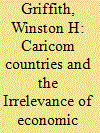

|
|
|
|
|
| Publication |
2007.
|
| Summary/Abstract |
The pioneers of development argued that natural resources determined a country's economic structure of production. Since a small country would of necessity have a smaller endowment of natural resources than a large country, they further argued that the economic structure of production of a small country would be more concentrated than that of a large country. This article contends that economic smallness is no longer an important determinant of a country's economic structure of production. The global economy is becoming more and more integrated and knowledge skills have become the most important resource in production processes. If, therefore, small countries such as those in Caricom can accumulate in sufficient quantities the appropriate knowledge skills, they can have a diversified economic structure of production by developing new products and services, and by attracting foreign direct investment
|
|
|
|
|
|
|
|
|
|
|
|
|
|
|
|
| 2 |
ID:
127820
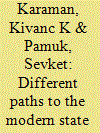

|
|
|
|
|
| Publication |
2013.
|
| Summary/Abstract |
Theoretical work on taxation and state-building borrows heavily from early modern European experience. While a number of European states increased centralized tax revenues during this period, for others revenues stagnated or even declined and these variations have motivated alternative arguments for the determinants of fiscal and state capacity. This study reviews the arguments concerning the three determinants that have received most attention, namely warfare, economic structure, and political regime, and tests them by making use of a new and comprehensive tax revenue dataset. Our main finding is that these three determinants worked in interaction with each other. Specifically, when under pressure of war, it was representative regimes in more urbanized-commercial economies and authoritarian regimes in more rural-agrarian economies that tended to better aggregate domestic interests towards state-building.
|
|
|
|
|
|
|
|
|
|
|
|
|
|
|
|
| 3 |
ID:
083097


|
|
|
|
|
| Publication |
2008.
|
| Summary/Abstract |
The economic analysis of organised crime suggests that some economic activities are particularly vulnerable to penetration by criminal organisations. This paper provides an analysis of the structure of the Sicilian economy and shows that, when compared with other Italian regions, it is characterised by a disproportionate presence of such activities. In particular, the economy of Sicily appears characterised by: (i) a large dimension of traditional sectors, such as the Construction sector, which also has a strong territorial specificity; (ii) a large presence of small firms; (iii) a low level of technology; (iii) a large public sector. The joint presence of these features creates fertile soil for the typical activities of organised crime, such as extortion and cartel enforcement. Hence, we propose an alternative explanation of the persistence of organised crime with respect to explanations based on cultural and social factors.
|
|
|
|
|
|
|
|
|
|
|
|
|
|
|
|
| 4 |
ID:
130494
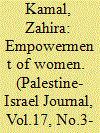

|
|
|
|
|
| Publication |
2011.
|
| Summary/Abstract |
The concept of women's empowerment is historically associated with national liberation movements throughout the world. the contributions of the American civil rights movement, and contributions of feminist movements in developing countries in Latin America and Asia. This concept focused on collective empowerment challenging the stereotypes about gender relations and was used, clearly and explicitly. in the l970s in order to launch the struggle for social justice and equality between women and men._ and facilitated through the establishment of economic, social and political structures. During the 1990s this concept lost its original transformational, and to a degree radical. concept, when it was linked to the ongoing transformations in the global economy and changes in the nature of the state and civil society. and to improvements at the level of development theories. Development discourse has focused on expanding women's options and levels of production as individuals, in most cases apart from the work programs of' women's -movements in the context of the state's withdrawal and abandoning of' its responsibilities in the spheres of economic and social support.'
|
|
|
|
|
|
|
|
|
|
|
|
|
|
|
|
| 5 |
ID:
175604


|
|
|
| 6 |
ID:
095883
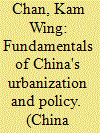

|
|
|
|
|
| Publication |
2010.
|
| Summary/Abstract |
This paper analyses the fundamentals of China's urbanization in the last two decades, focusing on the administrative and economic structures and policy which form the basis of the configuration of China's urban system and urbanization policy.
|
|
|
|
|
|
|
|
|
|
|
|
|
|
|
|
| 7 |
ID:
168296
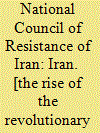

|
|
|
|
|
| Publication |
Washington, DC, NCRI, 2017.
|
| Description |
173p.hbk
|
| Standard Number |
9781944942021
|
|
|
|
|
|
|
|
|
|
|
|
Copies: C:1/I:0,R:0,Q:0
Circulation
| Accession# | Call# | Current Location | Status | Policy | Location |
| 059735 | 955/NAT 059735 | Main | On Shelf | General | |
|
|
|
|
| 8 |
ID:
130917


|
|
|
|
|
| Publication |
2014.
|
| Summary/Abstract |
Despite India's resurgent growth over the past years, the country seems to have failed miserably on the employment front. The employment content of economic growth-the employment intensity of growth-is on the decline. The objective of the present study is to identify the macroeconomic determinants which influence the employment intensity of growth in India. The study covers data for the period 1993-94 to 2009-10 across 15 major Indian states and applies a panel data model to find out these determinants. The results tend to suggest that labour supply, economic structure, price instability and human capital are major determining factors. Pro-employment growth in India may require measures like diversification of economic activities towards labour-intensive sectors, price stability, skill-based education and adoption of labour-intensive technology.
|
|
|
|
|
|
|
|
|
|
|
|
|
|
|
|
| 9 |
ID:
130918


|
|
|
|
|
| Publication |
2014.
|
| Summary/Abstract |
A far-sighted food policy is essential to facilitate efficient functioning of food production and management systems, especially for a country like India where household level food security still remains elusive. In this context, reliable mechanisms for generating outlooks on key variables such as demand, supply, trade, prices, etc., of important food commodities forms an essential basis for planning. This paper explores the theoretical underpinnings as well as practical applications of the Cereal Outlook Model, a dynamic, partial-equilibrium model, developed by the authors with the specific purpose of generating future outlooks on major cereals in India. Based on this, projections as well as policy simulations on main demand and supply side variables of rice, wheat and maize were carried out for the period spanning 2011-2025. The model results indicate fast-growing trends in demand and supply of the three cereals considered. Though growth in demand would be sufficiently high due to growing per capita income, population and urbanisation; supply would keep pace owing to the emergence of new areas contributing towards incremental production. Consequently, the net trade of all three commodities would remain positive, though some signs of tapering off in net trade are expected in case of wheat and maize.
|
|
|
|
|
|
|
|
|
|
|
|
|
|
|
|
| 10 |
ID:
092817


|
|
|
|
|
| Publication |
2009.
|
| Summary/Abstract |
This paper investigates the long-run equilibrium relationships, temporal dynamic relationships and causal relationships between energy consumption structure, economic structure and energy intensity in China. Time series variables over the periods from 1980 to 2006 are employed in empirical tests. Cointegration tests suggest that these three variables tend to move together in the long-run. In addition, Granger causality tests indicate that there is a unidirectional causality running from energy intensity to economic structure but not vice versa. Impulse response analysis provides reasonable evidences that one shock of the three variables will cause the periods of destabilized that followed. However, the impact of the energy consumption structure shock on energy intensity and the impact of the economic structure shock on energy consumption structure seem to be rather marginal. The findings have significant implications from the point of view of energy conservation and economic development. In order to decrease energy intensity, Chinese government must continue to reduce the proportion of coal in energy consumption, increase the utilization efficiency of coal and promote the upgrade of economic structure. Furthermore, a full analysis of factors that may relate to energy intensity (e.g. energy consumption structure, economic structure) should be conducted before making energy policies.
|
|
|
|
|
|
|
|
|
|
|
|
|
|
|
|
| 11 |
ID:
134181
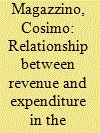

|
|
|
|
|
| Publication |
2014.
|
| Summary/Abstract |
The aim of this study is to assess the relationship between revenue and expenditure in the ASEAN countries. Using annual data for the period between 1980 and 2012 in ten member states, a long-run relationship between government expenditure and revenue emerges, both in ASEAN-6 and ASEAN-10 countries. Granger causality analysis shows mixed results, even though for five ASEAN countries the predominance of "tax-and-spend" hypothesis exists, given that government revenue drives the expenditure. Moreover, mixture models seem to produce homogeneous groups, considering the socio-economic structure, welfare state, and historical aspects. Finally, convergence measures show interesting results, confirming the sample's heterogeneity.
|
|
|
|
|
|
|
|
|
|
|
|
|
|
|
|
| 12 |
ID:
106454


|
|
|
|
|
| Publication |
2011.
|
| Summary/Abstract |
Russia's political-economic structure is a neo-Tsarist patrimonial one that fuses together power and position in traditional, even medieval ways. As a result its economy is hobbled by pervasive systemic corruption, misrule, and chronic sub-optimal outcomes. Of necessity these outcomes have a profound impact on Russian security and defense agendas. This article focuses on the relationship between these pathologies of Russian governance and the security and defense situation in regard to Russia's positions in the Russian Far East (RFE) and in comparison with China. It argues that these security and defense outcomes arising out of these pathologies of misrule are undermining Russia's basis for independent action in the Far East and its ability to assume not only a strong security and defense posture in that region, but also its ability to play an independent role in Asia.
|
|
|
|
|
|
|
|
|
|
|
|
|
|
|
|
| 13 |
ID:
130821
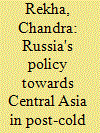

|
|
|
| 14 |
ID:
129265
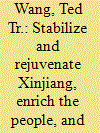

|
|
|
|
|
| Publication |
2012.
|
| Summary/Abstract |
I have come to Xinjiang this time mainly to do some investigating and research for implementing the scientific concept of development, promoting economic and social development, and enhancing Party construction. What I have seen and heard over the past few days deeply impresses me. The last time I came to Xinjiang was in June 2001. Returning again after more than five years, we are happy to see that gratifying achievements have been made in Xinjiang's economic and social development and that significant changes have occurred in the appearance of towns and countryside. These are fairly outstanding in the following respects. First, the economy has maintained fairly rapid growth. Last year's gross domestic product (GDP) in the region reached RMB260,900,000,000, an increase of 10.9 percent over the previous year, and in the first half of this year GDP in the region reached RMB105,200,000,000, rising 11.2 percent over the same period last year. Second, there have been swifter adjustments in the economic structure, with accelerated open-ing up of competitive resources and stepped-up development of special industries.
|
|
|
|
|
|
|
|
|
|
|
|
|
|
|
|
| 15 |
ID:
087726


|
|
|
|
|
| Publication |
New Delhi, Sage Publications, 1986.
|
| Description |
369p.
|
|
|
|
|
|
|
|
|
|
|
|
Copies: C:1/I:0,R:0,Q:0
Circulation
| Accession# | Call# | Current Location | Status | Policy | Location |
| 027487 | 338.9545/CHA 027487 | Main | On Shelf | General | |
|
|
|
|
| 16 |
ID:
046414


|
|
|
|
|
| Publication |
Cambridge, Cambridge University Press, 2001.
|
| Description |
xvi, 193cm.pbk
|
| Series |
China Quarterly Special Issues New Series no;1
|
| Standard Number |
0521003431
|
|
|
|
|
|
|
|
|
|
|
|
Copies: C:1/I:0,R:0,Q:0
Circulation
| Accession# | Call# | Current Location | Status | Policy | Location |
| 045058 | 951.249/EDM 045058 | Main | On Shelf | General | |
|
|
|
|
| 17 |
ID:
130976
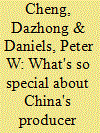

|
|
|
|
|
| Publication |
2014.
|
| Summary/Abstract |
In the present study, five stylized facts about China's producer services are established through international, intersectoral and intertemporal comparisons based on input-output tables. First, the overall service input ratio is the lowest in all the sample economies. Second, most producer services are supplied by the traditional labor-intensive sectors. Third, manufacturing is the biggest user of producer services, and service industry is the second, while the opposite is true for most of the other sample economies. Fourth, unlike other economies, China's "R&D" is characterized more by consumer services than producer services. Fifth, China has fairly lower service input ratios in almost all the industries. The backward and forward linkages coefficients are both smaller for "real estate activities" and "finance and insurance." Policy reform should focus not only on specific producer services but also on reducing obstacles that are inhibiting the balanced development of diverse producer services that will help China to optimize its economic structure.
|
|
|
|
|
|
|
|
|
|
|
|
|
|
|
|
|
|
|
|
|